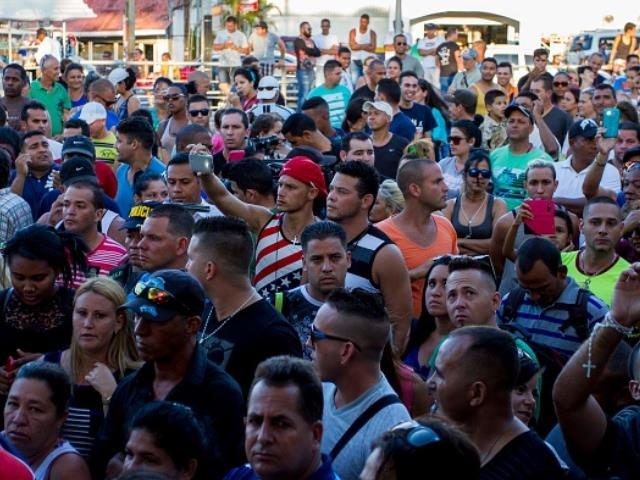Results 1 to 1 of 1
Thread Information
Users Browsing this Thread
There are currently 1 users browsing this thread. (0 members and 1 guests)
-
05-16-2016, 09:56 PM #1
Cuban Migration to U.S. Increases Six-Fold Under Obama Administration
Cuban Migration to U.S. Increases Six-Fold Under
Obama Administration

by Caroline May16 May 2016
The number of Cuban migrants seeking asylum at U.S. ports of entry has skyrocketed since President Obama took office — increasing six-fold since 2009 and nearly doubling from 2014 to 2015, according to the Center for Immigration Studies.
“The problem with the processes and the flows that we’re seeing is the Cuban Adjustment Act and the accompanying ‘wet-foot, dry-foot’ policy were intended for refugees in dealing with the flows we were experiencing during the Cold War and under the communist regime in place at the time,” Kausha Luna, a CIS research associate and author of a new report on Cuban migration, told reporters during a conference call Monday.
“The issue now is that these migrants are generally not refugees,” she stressed.
Cubans who reach the U.S. are largely granted automatic refugee status under the under the Cuban Adjustment Act (CAA), a benefit which affords them immediate eligibility for welfare benefits and an expedited path to permanent residency.
In FY 2009 — a relative low-point in Cuban migration to the U.S. — just 7,054 visa-less Cuban asylum-seekers entered the U.S. The levels of Cubans seeking entry to the U.S. has increased each year since, hitting 24,277 in FY 2014 and doubling in FY 2015 to 43,152. FY 2016 (with 25,806 visa-less Cuban migrant entries in the first five months) is already on pace to dwarf FY 2015.
Beyond the Cold War era CAA, according to Luna and CIS, a perfect storm of Obama administration and international policy changes have facilitated the surge in Cuban migration.
Specifically in 2013, the Castro regime in Cuba lifted travel restrictions allowing its citizens to more easily leave the island nation. Further, prior to December 2015, Cubans did not need a visa to travel to Ecuador, meaning Cubans were able to travel visa-less to Ecuador and commence a land migration route to the U.S.
Meanwhile, in 2009, the Obama administration lifted the limits on remittence to Cuba and the amount licensed travelers may carry to Cuba. Further, the administration’s move to normalize relations with Cuba has sparked concerns that the special protections afforded Cubans under the CAA will come to an end.
“Here we see that the policies in place are indeed not serving refugees but are creating a magnet for an array of Cuban migrants, generally economic migrants,” Luna noted.
Dan Cadman, a CIS fellow who also participated in Monday’s conference call with reporters, added that there is nothing in the CAA that requires all Cubans be granted protection and that the U.S. government could tamp down the flow by requiring that Cuban asylum seekers prove they have a credible fear of returning to Cuba.
“If the United States government chooses another course, as it has in this case, essentially they are condoning an organized smuggling ring involving tens of thousands of individuals,” Cadman said.
The increases of migrants seeking asylum at U.S. ports of entry is not unique to Cubans, as CIS research director Jessica Vaughan detailed. In fact Vaughan told reporters that nationals from around the world end up at specific and often distinct ports of entry along the U.S.-Mexico border.
“We’re also seeing spikes of arrivals of Chinese, Indians, Ecuadorians, Venezuelans, Haitians, Brazilians into Brownsville, Texas, Eritreans into Hidalgo,” she said.
Vaughan continued, “There are discernible patterns that Customs and Border Patrol have seen — for example the Brazilians go to Brownsville, the Haitians go to San Diego, the Indians go to Arizona, the Eritreans go to Hidalgo — which indicates there are organized smuggling rings, well aware of what U.S. policies are and what will happen to people when they arrive at the legal port of entry and claim asylum.”
“They are coached on what to say, they know what the result will be. And under the current administration the result will be that they will be allowed to stay and make an asylum claim,” she added.
http://www.breitbart.com/big-governm...dministration/
Similar Threads
-
FEARS OF OBAMA ELIMINATING REFUGEE STATUS SPIKES CUBAN MIGRATION TO US
By Newmexican in forum illegal immigration News Stories & ReportsReplies: 1Last Post: 01-31-2015, 07:40 PM -
Number of Cuban Immigrants Trying to Enter U.S Illegally Increases by 75 Percent
By JohnDoe2 in forum illegal immigration News Stories & ReportsReplies: 3Last Post: 10-07-2014, 01:03 AM -
Culture Shift: Obama Administration Rolls Out ‘Unlawful Migration’ To Replace Illegal
By AirborneSapper7 in forum General DiscussionReplies: 1Last Post: 06-25-2014, 12:19 PM -
Recession Slows Cuban Migration
By swatchick in forum illegal immigration News Stories & ReportsReplies: 3Last Post: 04-30-2009, 08:48 PM -
Increases illegal migration from Cuba to U.S.A.
By minnie in forum illegal immigration News Stories & ReportsReplies: 0Last Post: 10-01-2007, 11:53 PM


 LinkBack URL
LinkBack URL About LinkBacks
About LinkBacks




 Reply With Quote
Reply With Quote


Oklahoma House passes bill making illegal immigration a state...
04-19-2024, 05:14 AM in illegal immigration News Stories & Reports